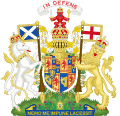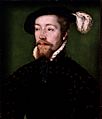List of Scottish monarchs facts for kids
Quick facts for kids Monarchy of Scotland |
|
|---|---|
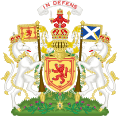
|
|
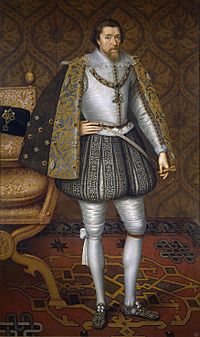
|
|
| Details | |
| First monarch | Kenneth I |
| Last monarch | Anne |
| Formation | 843 (traditional) |
| Abolition | 1 May 1707 |
| Residence | Royal Court of Scotland |
The monarch of Scotland was the head of state for the Kingdom of Scotland. This means they were the top leader of the country.
Traditionally, the first King of Scotland was Kenneth I MacAlpin. He is believed to have started the Scottish state in 843.
Over time, the "Kingdom of the Picts" became known as the Kingdom of Alba. This name later changed to Scotland in English and Scots. By the late 11th century, Scottish kings called themselves "King of Scots."
In 1707, the Kingdom of Scotland joined with the Kingdom of England. They formed a new country called the Kingdom of Great Britain. Queen Anne was the last monarch of Scotland and England. She became the first monarch of Great Britain.
Scotland and England had shared a ruler since 1603. This was called the Union of the Crowns. Queen Anne's uncle, Charles II, was the last king crowned in Scotland. This happened at Scone in 1651.
Contents
- Symbols of Scottish Kings and Queens
- Kings and Queens of Scotland
- The Alpin Family (848–1034)
- The Dunkeld Family (1034–1040)
- The Moray Family (1040–1058)
- The Dunkeld Family (Restored) (1058–1286)
- The Sverre Family (1286–1290)
- First Time Without a King (1286–1292)
- The Balliol Family (1292–1296)
- Second Time Without a King (1296–1306)
- The Bruce Family (1306–1371)
- The Balliol Family (Disputed Claim) (1332–1356)
- The Stewart/Stuart Family (1371–1651)
- Third Time Without a King (1651–1660)
- The Stuart Family (Restored) (1660–1707)
- The Acts of Union
- Later Claimants to the Throne
- Timeline of Scottish Monarchs
- The Coronation Oath
- Images for kids
- See also
Symbols of Scottish Kings and Queens
Kings and Queens of Scotland
The Alpin Family (848–1034)
The time of Kenneth MacAlpin is often called the start of the Alpin family. This is a modern way of thinking about it. Kenneth MacAlpin's family had two main branches. The crown would often switch between these two branches. Sometimes, a king from one branch would die in battle or a conflict with someone from the other branch.
Malcolm II was the last king from the Alpin family. He managed to stop all challenges to his rule. He had no sons, so he passed the crown to his daughter's son, Duncan I. This started the Dunkeld family.
| Name Reign |
Key Fact |
|---|---|
| Kenneth I MacAlpin 843/848 – 858 |
Considered the first King of Scotland. |
| Donald I 858 – 862 |
Brother of Kenneth I. |
| Constantine I 862–877 |
Son of Kenneth I. |
| Áed 877–878 |
Son of Kenneth I. |
| Giric 878–889 |
Possibly a son of Donald I. |
| Eochaid 878–889?* |
Grandson of Kenneth I. His rule is not fully clear. |
| Donald II 889–900 |
Son of Constantine I. |
| Constantine II 900–943 |
Son of Áed. |
| Malcolm I 943–954 |
Son of Donald II. |
| Indulf 954–962 |
Son of Constantine II. |
| Dub 962–967 |
Son of Malcolm I. |
| Cuilén 967–971 |
Son of Indulf. |
| Amlaíb 973–977¤ |
Son of Indulf. |
| Kenneth II 971–995 |
Son of Malcolm I. |
| Constantine III 995–997 |
Son of Cuilén. |
| Kenneth III 997 – 1005 |
Son of Dub. |
| Malcolm II 1005–1034 |
Son of Kenneth II. Last king of the Alpin family. |
*Eochaid was the grandson of Kenneth I. It's not clear if he was truly a king. If he was, he might have ruled alongside Giric. ¤Amlaíb is only known from a record of his death in 977. He was called King of Alba then.
The Dunkeld Family (1034–1040)
Duncan became king because he was the grandson of Malcolm II through his mother. So, the Dunkeld family was closely related to the Alpin family. Duncan was killed in battle by Macbeth. Macbeth was also a grandson of Malcolm II.
| Name Reign |
Key Fact |
|---|---|
| Duncan I 1034–1040 |
Grandson of Malcolm II. Killed in battle by Macbeth. |
The Moray Family (1040–1058)
Macbeth became king in 1040 after defeating Duncan I in battle. He ruled for a long time and was quite successful. Macbeth was a cousin of Duncan and also a grandson of Malcolm II.
Between 1057 and 1058, Duncan's son, Malcolm III, fought and defeated Macbeth. Malcolm III also defeated Lulach, Macbeth's stepson and heir. Malcolm III then became king, bringing the throne back to the Dunkeld family.
| Name Reign |
Key Fact |
|---|---|
| Macbeth 1040–1057 |
Cousin of Duncan I. Ruled for 17 years. |
| Lulach 1057–1058 |
Macbeth's stepson. Ruled for a short time. |
The Dunkeld Family (Restored) (1058–1286)
After defeating Macbeth and Lulach, Malcolm III became king. But family conflicts didn't stop. When Malcolm III died, his brother Donald III (known as "Bán") claimed the throne. Donald III forced Malcolm III's sons out of Scotland.
A civil war then broke out within the family. Donald III and Malcolm III's son Edmund were opposed by Malcolm III's other sons. These sons were supported by England. First, Duncan II led them, then Edgar. Edgar won, sending his uncle and brother to monasteries.
After David I's rule, the Scottish throne usually passed from father to son. If there was no son, it went to a brother. Alexander III was the last ruler from the Dunkeld family. He had no sons, so his granddaughter, Margaret, Maid of Norway, inherited the throne.
| Name Reign |
Key Fact |
|---|---|
| Malcolm III 1058–1093 |
Son of Duncan I. Restored the Dunkeld family. |
| Donald III 1093–1097 |
Brother of Malcolm III. |
| Duncan II 1094 |
Son of Malcolm III. Ruled briefly. |
| Edgar 1097–1107 |
Son of Malcolm III. |
| Alexander I 1107–1124 |
Son of Malcolm III. |
| David I 1124–1153 |
Son of Malcolm III. Known for his reforms. |
| Malcolm IV 1153–1165 |
Grandson of David I. |
| William I 1165–1214 |
Grandson of David I. Ruled for a long time. |
| Alexander II 1214–1249 |
Son of William I. |
| Alexander III 1249–1286 |
Son of Alexander II. Last of the Dunkeld family. |
The Sverre Family (1286–1290)
Margaret, Maid of Norway became queen in 1286. She was very young and lived in Norway. Scotland was ruled by special "guardians" while she was away. Sadly, Margaret died in 1290 on her way to Scotland to be crowned. She was only seven years old.
Historians debate if Margaret was truly a queen since she was never crowned. After her death, Scotland had a period without a king. Many people wanted to be the next ruler. Eventually, John Balliol became king.
| Name Reign |
Key Fact |
|---|---|
| Margaret 1286–1290 |
Granddaughter of Alexander III. Died before being crowned. |
First Time Without a King (1286–1292)
This period began when Alexander III died in 1286. His only living grandchild was Margaret, who was a child. Guardians were chosen to rule Scotland because she was in Norway. Margaret died in 1290 before reaching Scotland. It took until 1292 to decide who the next king would be.
The Balliol Family (1292–1296)
Margaret of Norway's death led to a two-year crisis. There was no clear heir to the throne. Thirteen people claimed the crown. The most important were John Balliol and Robert de Brus, 5th Lord of Annandale. Both were related to earlier kings.
Scottish leaders asked Edward I of England to help decide. He chose John Balliol. But Edward I then tried to take control of Scotland. John Balliol was not a strong ruler. In 1296, Edward I forced him to give up the throne. Edward I then tried to make Scotland part of England.
| Name Reign |
Key Fact |
|---|---|
| John Balliol 1292–1296 |
Chosen by Edward I of England. Forced to give up his throne. |
Second Time Without a King (1296–1306)
John Balliol gave up his throne in March 1296. That same month, Edward I invaded Scotland. New guardians were appointed by Edward I. They ruled Scotland from 1296 to 1306. This period ended when Robert the Bruce was chosen as the new King of Scotland.
The Bruce Family (1306–1371)
For ten years, Scotland had no king. But the Scots did not want English rule. Leaders like William Wallace, Andrew Moray, and Robert the Bruce fought against England.
Robert the Bruce and his supporters had a conflict with their rival, John Comyn, in 1306. Soon after, Robert was crowned King of Scots at Scone. Robert Bruce then faced challenges and had to leave the country for a time. The English invaded again.
Bruce returned a year later and gained support. He was a strong leader. Also, the powerful Edward I of England died in 1307. His son, Edward II, was weaker. This helped Scotland gain its freedom. At the Battle of Bannockburn in 1314, the Scots won a big victory against the English. By 1328, England agreed to accept Scotland's independence.
Robert's son, David, became king as a child. England started another war with Scotland. David had to flee the kingdom. Edward Balliol, John Balliol's son, managed to become king for a short time (1332–1356). He gave away some Scottish lands to England before being driven out. David spent much of his life away from Scotland, first in France, then as a prisoner in England. He returned to Scotland in 1357. When he died in 1371, he had no children. This ended the Bruce family's rule.
| Name Reign |
Key Fact |
|---|---|
| Robert I 1306–1329 |
Led Scotland to independence from England. |
| David II 1329–1371 |
Son of Robert I. Faced renewed English wars. |
The Balliol Family (Disputed Claim) (1332–1356)
Edward Balliol was the son of King John Balliol. John had ruled for four years after being chosen king. After his father gave up the throne, John Balliol lived quietly in France.
While David II was a child, Edward Balliol saw a chance to claim the throne. With English support, he defeated David's forces. He was crowned king at Scone in 1332. But he was quickly defeated by those loyal to David and sent back to England.
With English help, he tried to take the throne two more times, in 1333 and 1335. Each time, his rule was very short before he was sent back to England. The last time was in 1336. When David returned from exile in 1341, Edward lost most of his support. Edward made one last attempt in 1346 when David II was captured. But he had little support. In 1356, he gave up all claims to the throne.
| Name Reign |
Key Fact |
|---|---|
| Edward Balliol 1332–1356 (Challenged David II) |
Son of John Balliol. Claimed the throne with English support. |
The Stewart/Stuart Family (1371–1651)
Robert the Stewart was the grandson of Robert I. He was born in 1316, making him older than his uncle, David II. So, when he became king, he was already 55 years old. This meant he couldn't rule as strongly. His son, Robert III, also became king when he was older (53 in 1390). Robert III also had lasting injuries from a horse-riding accident.
After these two kings, there were many periods where young boy kings ruled. This meant others had to govern for them. During these times, powerful nobles often took power from the crown. When the kings grew up, they tried to fix the problems caused by these periods. Ruling Scotland became harder as the nobles became more difficult to control.
James I tried to bring order but was killed. James III died in a civil war against nobles led by his own son. When James IV died in battle, his wife Margaret Tudor was supposed to rule for their young son James V. But noble conflicts removed her. James V's wife, Mary of Guise, managed to rule for her young daughter Mary I by cleverly dividing the noble groups.
Finally, Mary I, James V's daughter, found it hard to rule Scotland. The nobles were unhappy, and many people preferred Protestantism over her Catholicism. She was forced to give up her throne and fled to England. There, she was held prisoner for 18 years and later executed. After she gave up the throne, her son, James VI, became king.
James VI also became King of England and Ireland in 1603. This happened when his cousin Elizabeth I died. After this, the kings mostly lived in England. The crowns of England and Scotland were still separate, but they had the same ruler.
Charles I, James's son, faced a Civil War. This war lasted eight years and ended with his execution. The English Parliament then said their monarchy was over. The Scottish Parliament decided to break ties with England. They declared Charles II, Charles I's son, as their new king. He ruled until 1651. Then, Oliver Cromwell's armies took over Scotland and forced Charles II to leave the country.
| Name Reign |
Key Fact |
|---|---|
| Robert II 1371–1390 |
Grandson of Robert I. First king of the Stewart family. |
| Robert III 1390–1406 |
Son of Robert II. |
| James I 1406–1437 |
Son of Robert III. Tried to bring order to the kingdom. |
| James II 1437–1460 |
Son of James I. |
| James III 1460–1488 |
Son of James II. Died in a conflict with nobles. |
| James IV 1488–1513 |
Son of James III. Died in the Battle of Flodden. |
| James V 1513–1542 |
Son of James IV. |
| Mary I 1542–1567 |
Daughter of James V. Faced many challenges and was forced to abdicate. |
| James VI 1567–1625 |
Son of Mary I. Became King of England in 1603. |
| Charles I 1625–1649 |
Son of James VI. Executed after the English Civil War. |
| Charles II 1649–1651 |
Son of Charles I. Ruled briefly before being forced into exile. |
Third Time Without a King (1651–1660)
This period was when England was a republic under Oliver Cromwell. Scotland was occupied by Cromwell's armies, and there was no king.
The Stuart Family (Restored) (1660–1707)
With the Scottish Restoration, the Stuart family became Kings of Scotland again. But Scotland's rights were not always respected. During Charles II's rule, the Scottish Parliament was dissolved for a time. James (Charles II's brother) was made Governor of Scotland.
James became King James VII in 1685. He was Catholic, which many people did not like. He was forced out of England after three years. His daughter Mary and her husband William of Orange (ruler of the Dutch Republic) then became rulers. The Scottish Parliament accepted them as monarchs. They ruled together as William II and Mary II.
Scotland tried to start its own colonial empire with the Darien Scheme. This plan failed and left many Scottish nobles who had invested in it without money. This happened around the time Queen Anne became queen. She was the daughter of James VII.
Queen Anne had many children, but none lived past childhood. This meant her half-brother, James, who was living in France, was her heir. However, the English preferred the Protestant Sophia of Hanover (a granddaughter of James VI) as heir. Many Scots preferred Prince James because he was a Stuart and had Scottish roots. They threatened to choose him as their king, which would break the Union of Crowns.
To keep the two kingdoms together, England planned to merge Scotland and England into one country. This new country would be the Kingdom of Great Britain. It would have one monarch and one Parliament. Both parliaments agreed to this, though the Scots were not entirely happy. They were motivated partly by Scotland's financial problems. After this, monarchs continued to rule Scotland, but they did so as rulers of Great Britain. From 1801, they ruled the United Kingdom.
| Name Reign |
Key Fact |
|---|---|
| Charles II 1660–1685 |
Restored to the throne after the period without a king. |
| James VII 1685–1688 |
Brother of Charles II. His Catholic faith led to his removal. |
| Mary II 1689–1694 |
Daughter of James VII. Ruled with her husband William II. |
| William II 1689–1702 |
Husband of Mary II. Ruled jointly with Mary. |
| Anne 1702–1707 |
Daughter of James VII. Last monarch of Scotland before the union with England. |
The Acts of Union
The Acts of Union were two laws passed in 1706 and 1707. They were passed by the Parliament of England and the Parliament of Scotland. These laws put into action the terms of the Treaty of Union, which was agreed on July 22, 1706.
These Acts joined the Kingdom of England and the Kingdom of Scotland. They formed a new, united country called the Kingdom of Great Britain.
Scotland and England had shared a ruler since 1603. This was when the Scottish king James VI also became the King of England. Before 1707, the two kingdoms were separate, but they had the same person as king or queen. There were three earlier attempts to unite the kingdoms (in 1606, 1667, and 1689). But it wasn't until the early 1700s that both countries' leaders wanted it to happen. This brought the two separate states together under one parliament and one monarch.
Later Claimants to the Throne
After he was removed from the throne, James VII still claimed to be the rightful king. When he died in 1701, his son James took on these claims. He called himself James VIII of Scotland. He continued to do this even after Scotland and England merged into Great Britain.
In 1715, James landed in Scotland and tried to take the throne. This was a year after his half-sister, Queen Anne, died. But he failed and had to flee back to Europe. His son, Charles, tried again in 1745-46. This attempt also failed. Both of James's children died without any children of their own. This brought the direct Stuart family line to an end.
- "James VIII", also known as The Old Pretender, was James VII's son. He claimed the throne from 1701 until his death in 1766.
- "Charles III", also known as The Young Pretender or Bonnie Prince Charlie, was James VIII's son. He claimed the throne from his father's death until his own death in 1788. He had no children.
- "Henry I", was Charles III's brother and James VIII's youngest son. He died in 1807 without marrying.
After 1807, the claims to the throne passed to other European royal families. The current heir is Franz, Duke of Bavaria. However, he and the others before him since 1807 have not actively pursued the claim.
In 1971, the President of Uganda, Idi Amin, said he was the uncrowned king of Scotland. But no other country recognized this claim.
Timeline of Scottish Monarchs
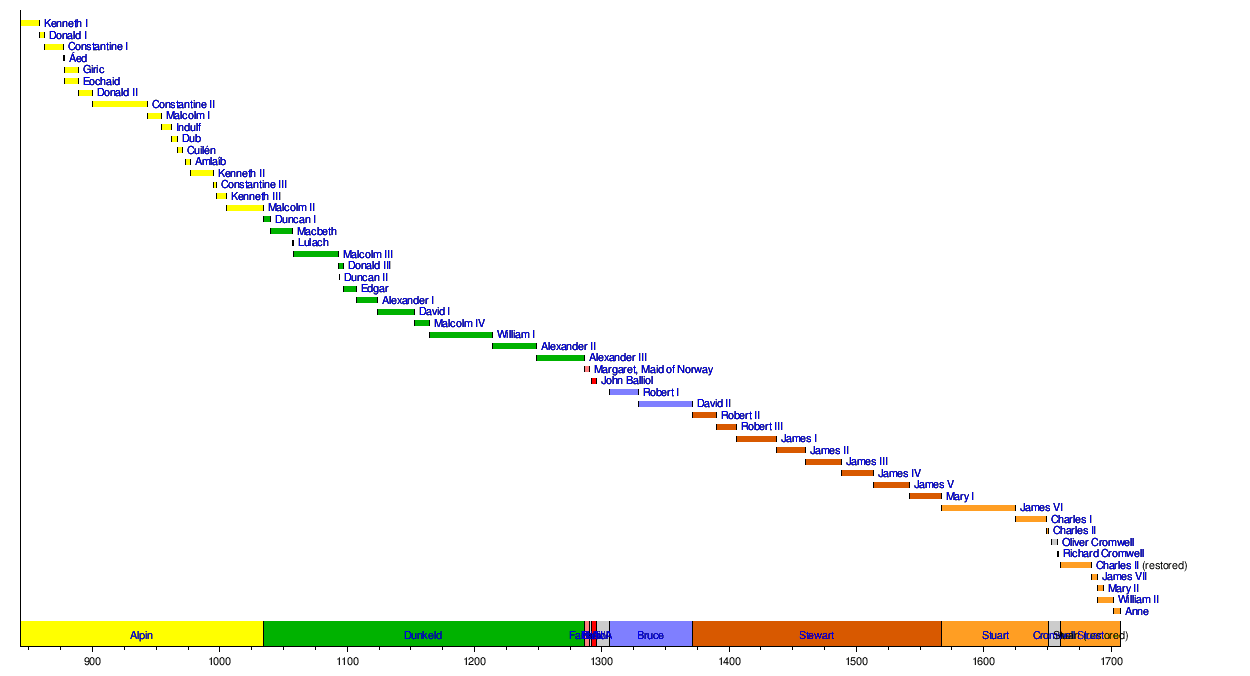
The Coronation Oath
The coronation oath was a promise made by every Scottish monarch. It was sworn by kings and queens from James VI to Charles II. The Scottish Parliament approved this oath in 1567.
Here is what the oath said:
I, N.N., promise faithfully, in the presence of the eternal, my God, that I, enduring the whole Course of my Life, shall serve the same Eternal, my God, to the utmost of my Power, accordingly as he required in his most Holy Word, revealed and contained in the New and Old Testament; and according to the same Word shall maintain the true Religion of Jesus Christ, the preaching of his Holy Word, and due and right administration of his Sacraments, now received and practised within this Realm; and shall abolish and oppose all false Religion contrary to the same; and shall rule the People committed to my Charge, according to the Will and Command of God, revealed in his foresaid Word, and according to the lovable Laws and Constitutions received in this Realm, in no way repugnant to the said Word of the Eternal, my God; and shall procure to my utmost to the Kirk of God and whole Christian people true and perfect Peace in all times coming; the Rights and Rents, with all just privileges of the Crown of Scotland, I shall preserve and keep inviolate, neither shall I transfer nor alienate the same; I shall forbid and repress in all Estates and all Degrees theft, Oppression and all kind of Wrong; in all Judgements, I shall command and procure that Justice and Equity be kept to all creatures without exception, as he be merciful to me and you that is the Lord and Father of all Mercies; and out of all my lands and empire I shall be careful to root out all Heresy and Enemies to the true Worship of God, that shall be convicted by the true Kirk of God of the foresaid Crimes; and these Things above-written I faithfully affirm by my solemn Oath.
The oath sworn by William II, Mary II and Anne was approved on April 18, 1689.
Here is what that oath said:
WE William and Mary, King and Queen of Scotland, faithfully promise and swear, by this our solemn Oath, in presence of the Eternal God, that during the whole Course of our Life we will serve the same Eternal God, to the uttermost of our Power, according as he has required in his most Holy Word, revealed and contained in the New and Old Testament; and according to the same Word shall maintain the true Religion of Christ Jesus, the preaching of his Holy Word, and the due and right Ministration of the Sacraments, now received and preached within the Realm of Scotland; and shall abolish and gainstand all false Religion contrary to the same, and shall rule the People committed to our Charge, according to the Will and Command of God, revealed in his aforesaid Word, and according to the laudable Laws and Constitutions received in this Realm, no ways repugnant to the said Word of the Eternal God; and shall procure, to the utmost of our power, to the Kirk of God, and whole Christian People, true and perfect Peace in all time coming. That we shall preserve and keep inviolated the Rights and Rents, with all just Privileges of the Crown of Scotland, neither shall we transfer nor alienate the same; that we shall forbid and repress in all Estates and Degrees, Reif, Oppression and all kind of Wrong. And we shall command and procure, that Justice and Equity in all Judgments be kept to all Persons without exception, us the Lord and Father of all Mercies shall be merciful to us. And we shall be careful to root out all Heretics and Enemies to the true Worship of God, that shall be convicted by the true Kirk of God, of the aforesaid Crimes, out of our Lands and Empire of Scotland. And we faithfully affirm the Things above-written by our solemn Oath.
Images for kids
See also
 In Spanish: Anexo:Monarcas de Escocia para niños
In Spanish: Anexo:Monarcas de Escocia para niños
- Scottish monarchs' family tree
- Palace of Holyroodhouse – A main home for the King of Scots.
- Duke of Rothesay – The title for the person next in line to the Scottish throne.
- List of Scottish consorts – A list of the spouses of Scottish monarchs.
- Lists of monarchs in the British Isles




